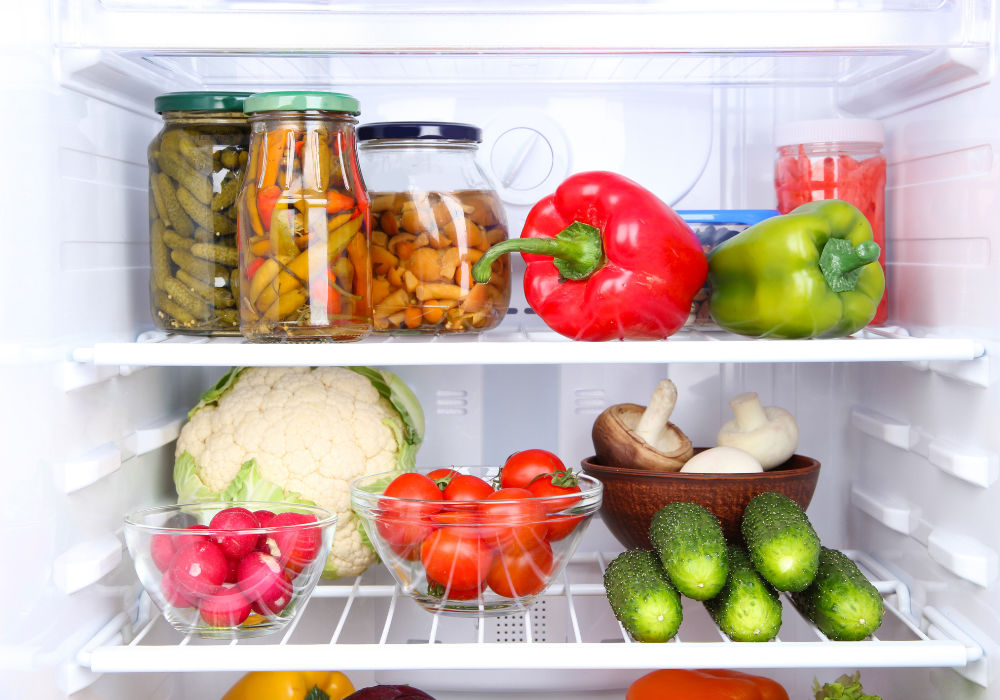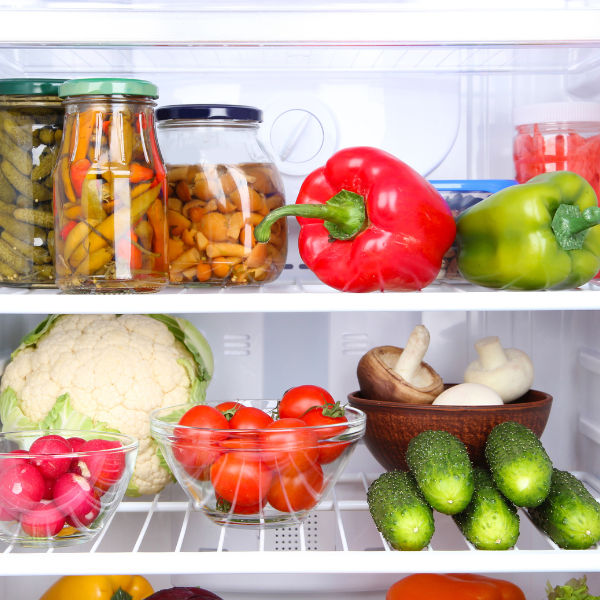In this blog post, you’ll discover the three steps that will help you set up your plant-based kitchen for success. These steps might seem basic, but combined they will make a powerful change to your environment, and thereby to your diet.
I know making the decision to go plant-based seems like the hard part. Maybe you wavered over this decision for months, or maybe you made up your mind overnight. Either way, that decision is the beginning of a new lifestyle for you. That alone deserves a celebration!
However, now the journey, and the real work, begin. Like any good process, you need to start at the beginning if you want to avoid overwhelm. In my mind, that means starting in your kitchen.
Tell me this: what does your kitchen look like right now? When you open up your fridge or pantry door, what do you see? If your answer includes lots of animal products and ultra-processed foods, setting up your kitchen to focus on plants is THE place to start your journey.
Changing your diet requires changing your habits. And changing your habits will be 100 times easier if you change the environment that influences those habits.
Start this new lifestyle by setting up your kitchen to aid you in your diet change. Remember, you want your environment to help, not hinder, you. Your plant-based kitchen will look somewhat different than your previous omnivorous kitchen. Specifically, you’ll need to change up many of the items in your pantry and fridge, and on your countertops.

You don’t have to do it alone though. Follow the three steps below and you’ll be surprised how much easier implementing your new diet will be!
Step 1: Clean your kitchen
You might be tempted to skip this step and get straight to the fun part, but resist that temptation! You’ll have so much more success if you start off with a clean slate. Starting off with a clean kitchen is key! Think of it as a mini spring cleaning. You need to give your kitchen (specifically your fridge and pantry) a proper spring cleaning before jumping into reorganizing.
Our kitchen is the home of our diet, after all!
How to clean your kitchen
- Take everything out of your fridge and put it on the counter. I mean it. Everything!
- Wipe down the inside of the fridge; don’t forget the door, the underside of the shelves, the cheese & meat drawer, and the produce bins.
- Repeat steps one and two with your pantry.
- Don’t put your food away yet! Leave everything on your counter and proceed to step 2.
See, isn’t it nice to have a clean fridge?
Step 2: Clear out your fridge and pantry
Time to evaluate the items on your counter.
To help with this, group them into three categories.
- Put all the whole and minimally processed plant foods in one group. (Remember, this can include things like tempeh, tofu, plant-milk, Dijon mustard, hot sauce, and whole grain tortillas–things that you might not immediately think of as plant-based foods.)
- Next group all the animal products together. (This includes everything from meat, eggs, and milk, to coffee creamer, fish sauce, and chicken stock.)
- In the last group gather all the processed foods together. (This may include certain condiments, refined grains, soda, vegan meat substitutes, some snack foods, and anything with refined sugar.)
You should now have three groups of food. Put group #1 back in the fridge. Those are your whole plant-based foods. The goal is to have that group represent the majority of food in your kitchen.
Now it’s time to tackle groups #2 and 3.
This part of the process is unique to each of us. Refer back to your individual diet goals. You may be aiming for a plant-predominant diet and so you’ll want to maintain a small amount of animal products in your fridge. Alternatively, if your goal is a plant-exclusive diet, you’ll want to get rid of those products completely. (If you haven’t taken the time to get clear on your diet goals yet, do this first before proceeding! Click here to learn how to get clear on your diet goals.)
Now that you’re clear on your specific diet goals, it’s time to get back to the food sitting on your countertop. From each group, separate out what you want to keep and what you’ll get rid of and not buy again. This will look unique to each of us based on our individual diet goals.
If you choose to keep a small number of animal products in your kitchen and diet, follow these tips to maintain your healthy diet:
- Choose fish, seafood & eggs over other types of animal products – these products have potential health benefits over other forms of animal products
- Choose sheep and goat dairy (like goat cheese & feta) over cow dairy – these are easier to digest for most people
- Keep the majority of the food in your kitchen whole foods – you want to avoid products with a bunch of unknown, unpronounceable ingredients in them. That’s a great indicator of ultra-processed foods.

Strategies for getting rid of unwanted items in your plant-based kitchen
So now you’ve got all these foods on your counter that you’ve sorted into a “get rid of” pile and you’re thinking, “I have to throw all this away?!” Not so fast!
Although that might be the easiest thing to do, I don’t recommend throwing food away, ever. It’s wasteful and there are so many alternative ways to get rid of unwanted but still perfectly good foods.
Here are a few of my top strategies that you can use instead of wasting those foods.
- Prioritize eating them up over the next two to three weeks. The specific length of this strategy depends on how much stuff you have in the “get rid of” pile. (Meal planning will help you prioritize eating these foods. Click here to learn my step-by-step method for meal planning.)
- Give the unwanted food to neighbors, family, or friends. You can make this more fun by getting creative and putting together gift baskets of food you think each person will like and use.
- Donate the food to a food bank. This strategy is a great option if you have a lot of pantry items you want to get rid of. Most food banks will accept anything unopened, unexpired, and shelf stable.
- Use the ingredients to make food gifts for omnivorous friends or family. This is my favorite strategy! Can you blame me? It’s a wonderful excuse to make food for others. Look at the food you want to get rid of and come up with dishes you can make that will use up those foods. For example, use butter, eggs, and milk to bake a cake, or chicken and cheese to make enchiladas. You can even make it into a little party and enjoy the food gift together with your friends.
Step 3: Reorganize your kitchen to be plant-based focused
Your plant-based kitchen should inspire you to follow your new diet. For me, last-minute meal inspiration often comes from the fresh produce I have in my fridge or on my countertop.
As you reorganize your kitchen, consider these key strategies for setting up a plant-based kitchen successfully:
- Focus on whole plant foods (even if you’re eating a plant-predominant diet!). That means the majority of the food in your kitchen should be fruits, veggies, whole grains, legumes, nuts, seeds, herbs, and spices. Remember that this includes plant foods in other forms like hummus, frozen produce, soymilk, corn tortillas, and whole-grain bread.
- Aim for lots of colors in your plant-based kitchen. When you compare an omnivorous fridge with a plant-based fridge, you’ll notice that the latter has a lot more color in it, thanks to all the additional produce. No amalgamation of beige foods please!
- In the same vein, stock up on plenty of fresh fruit and veggies. As a general rule, people eating a plant-based diet need to consume a larger quantity of foods than those eating an omnivorous diet. This is because plant foods as a rule contain far fewer calories per the same volume than animal foods. (In the nutrition world we call this concept nutrient rich and calorie poor.) Given that, you’ll likely want to eat bigger serving sizes of your meals going forward. Personally, I love this fact because it means I get to eat more delicious food! 😀
- The last element of setting up your plant-based kitchen is to maintain a well-stocked pantry. Key foods in well-balanced plant-based meals are basic inexpensive pantry staples like whole grains, legumes, nuts, and seeds. You’d be surprised how much brown rice and quinoa a family of two can go through in just a few weeks! One tip I’ve found really helpful is to check out the bulk bins at my local grocery store for these items. You’ll often find plant-based pantry staples for much cheaper in bulk. For an in-depth guide on plant-based pantry staples, check out this super helpful three part series.
And there you have it. These three simple steps will have a massive impact on your diet change. Start your plant-based journey by setting up your plant-based kitchen and you’ll already be halfway to achieving your goals before you’ve even started!



